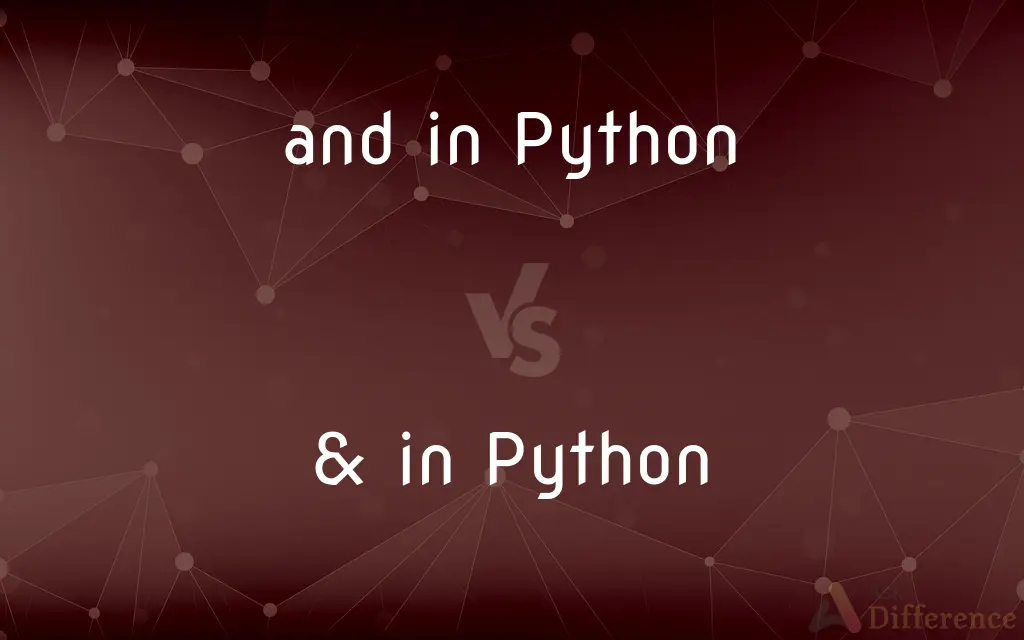and in Python vs. & in Python — What's the Difference?
By Tayyaba Rehman — Published on January 4, 2024
and is a logical operator for boolean contexts; & is a bitwise operator for bit-level operations.

Difference Between and in Python and & in Python
Table of Contents
ADVERTISEMENT
Key Differences
In Python, and is a logical operator used to combine boolean expressions. If both sides of and are true, the result is true; if either is false, the result is false. It works with True and False values and is commonly used in control flow statements.
The & operator in Python is a bitwise operator. It performs a bit-by-bit AND operation on the corresponding bits of integer operands. This means that each bit of the output is 1 if the corresponding bits of both operands are 1, otherwise, it's 0.
Logical and in Python evaluates the second argument only if the first one is True. It's because if the first argument is False, the whole expression is False regardless of the second argument. This is known as short-circuit evaluation.
Bitwise &, on the other hand, does not short-circuit. It always evaluates both operands. This is essential in cases where you are working with masks or need to perform bit-level manipulations on integer types.
Both and and & are fundamental operators in Python but serve very different purposes. and is for boolean logic, typically used in decision-making constructs, whereas & is for altering the binary bits of data.
ADVERTISEMENT
Comparison Chart
Type of Operator
Logical operator
Bitwise operator
Operands
Boolean values (True/False)
Integer values
Evaluation
Short-circuit evaluation
Always evaluates both operands
Usage
Control flow conditions
Bit-level operations, masking
Return Value
Returns a boolean or operand
Returns an integer
Compare with Definitions
and in Python
Can be used to chain multiple conditions.
If age > 18 and age < 65: pass
& in Python
Does not short-circuit.
Result = get_mask() & get_flags()
and in Python
Evaluates second operand only if first is True.
If user_exists() and login(user): pass
& in Python
Each bit in the result is set to 1 only if both bits are 1.
Bitwise_result = (0b1100 & 0b1010)
and in Python
Returns the first False value or the last operand if all are true.
Status = task_completed and all_tests_passed
& in Python
Requires integer operands.
Mask_result = a & 0xFF
and in Python
Short-circuits at the first operand that is False.
If access_level > 0 and modify_records(): pass
& in Python
Commonly used for masking operations.
If (byte & 0x1): pass
and in Python
Logical AND operator, returns True if both operands are true.
If is_admin and is_active: pass
& in Python
Bitwise AND operator, performs bit-by-bit comparison.
Flags = read_flags() & write_flags
Common Curiosities
Does & operator work on floats?
No, & is only for integer bitwise operations.
Do and and & have the same precedence?
No, & has higher precedence than and.
Are and and & interchangeable?
No, they serve different purposes and are not interchangeable.
How can I perform a bitwise AND on boolean values?
Cast them to integers first or use & with caution regarding precedence.
Can I use & for boolean logic?
It's not standard; & is meant for bitwise operations with integers.
Can I use & with strings?
No, & is not defined for string operands.
Can and be used with integers?
Not usually, as and is for boolean contexts, but Python does allow it by considering non-zero as True.
Can and change the data type of the result?
Yes, and can return any operand in the expression, not just booleans.
Why doesn't and give me a bit mask?
Because and is not a bitwise operator, it's for boolean operations.
Can & be used to combine two conditional statements?
No, & should not be used for conditional logic; it’s for bitwise operations.
What happens if I use & with two boolean operands?
It will perform a bitwise AND, but it’s unconventional for boolean logic.
Should I use and or & for filtering data in pandas?
Use & for element-wise bitwise AND when working with pandas Series or DataFrames.
Is and or & faster in Python?
This depends on the context; and might be faster due to short-circuiting.
How can I remember when to use and vs &?
Use and for logical operations in boolean expressions, use & for bit manipulation.
Is and used in conditional statements?
Yes, and is commonly used in if, while, and other conditional statements.
Share Your Discovery

Previous Comparison
List in Java vs. Set in Java
Next Comparison
Cache Memory vs. RegisterAuthor Spotlight
Written by
Tayyaba RehmanTayyaba Rehman is a distinguished writer, currently serving as a primary contributor to askdifference.com. As a researcher in semantics and etymology, Tayyaba's passion for the complexity of languages and their distinctions has found a perfect home on the platform. Tayyaba delves into the intricacies of language, distinguishing between commonly confused words and phrases, thereby providing clarity for readers worldwide.
















































